October 2025

The global smart bandages market size market is forecast to grow from USD 880.42 million in 2025 to USD 2518.71 million by 2034, driven by a CAGR of 11.5% from 2025 to 2034, as a result of the rising technological advancements and rising diabetic population.
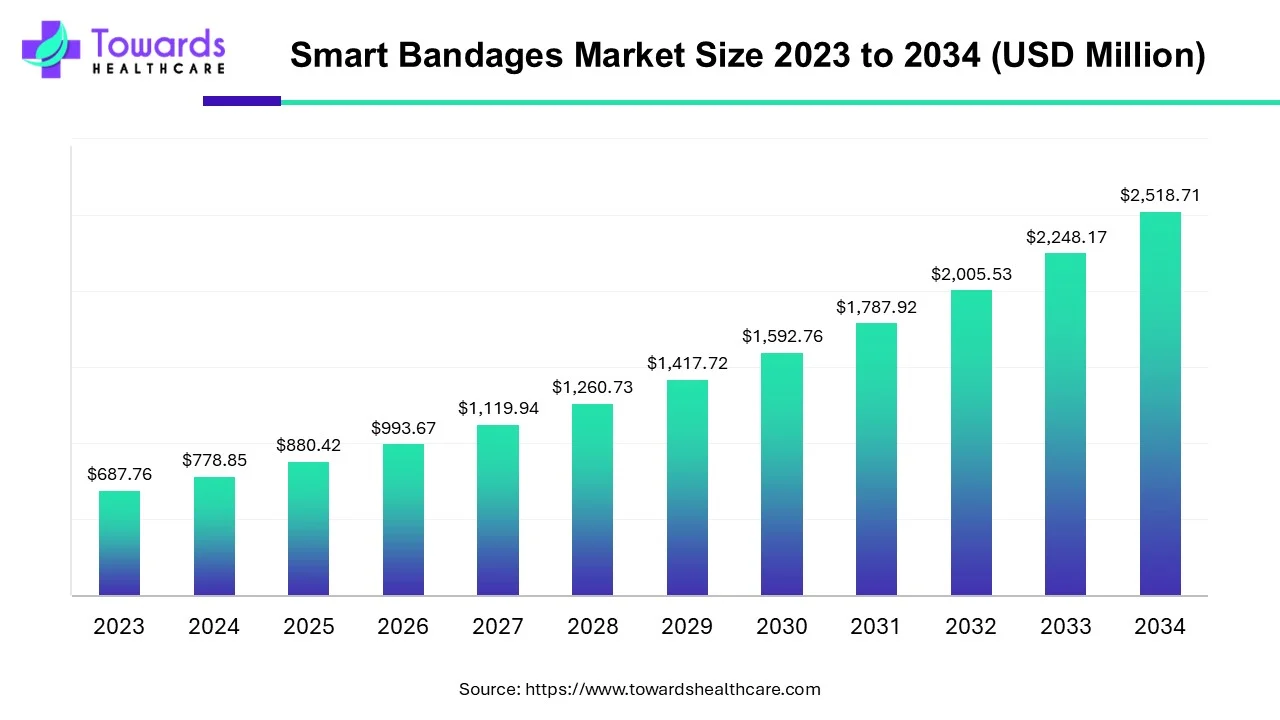
Artificial intelligence (AI) has been proven to be an integral part of the healthcare sector, revolutionizing the research process. It can be used to design and develop novel smart bandages for wounds or injuries. Integrating AI in smart bandages enhances efficiency and precision. AI-enabled sensors provide real-time wound healing monitoring of patient data, allowing healthcare professionals to make effective clinical decisions. The advent of wireless technology is crucial for smart bandages, providing reliable data. Thus, AI-enabled smart bandages present disruptive innovation opportunities in the medical device sector, improving the accuracy and convenience of wound healing monitoring.
For instance,
As per the National Institute of Health estimates, the global prevalence of diabetes will reach 10.2% (578 million) by 2030, and people with diabetes have a 25% chance of having DFUs during their lifetime.
Smart bandages, often known as "modern dressings", are used to treat patients more comfortably and conveniently while shortening the length of their hospital stays. This medical tool generates the ideal environment for complex and dynamic wounds to heal more swiftly and securely. Technology advancements have led to the creation of numerous wound dressings that target various components of the healing process and are used to treat various types of wounds. The emphasis in the treatment of wounds is changing away from the necessary drastic surgical debridement towards a non-surgical approach due to the introduction of technologically new and more advanced methods of non-surgical debridement of the wound, which have considerable clinical advantages.
When individuals experience a burn, scrape, cut, or other wound, their bodies often care for themselves and heal quickly. This, however, is not always the reality. Diabetes can impede the wound's healing process, causing wounds that won't heal and risk becoming infectious and decaying. These types of chronic wounds are not only devastating for the individuals who have them. Instead, they place a financial burden of $25 billion annually on healthcare systems in the United States alone.
Market players are extensively focusing on research and development in smart bandages, as this advanced technology offers several benefits over traditional wound healing treatments. Market players are also bringing novel products to the market with the adoption of advanced technology.
Thus, rising product innovations, growing R&D, and improving availability of products in the market augments the smart bandages market growth.
It is common to overlook the significance of end-user acceptance and the clearance procedure of regulatory authorities when attempting to foresee the future uses of wearables in the healthcare system and when considering their adaptability. All these problems could be solved by using bandages as the foundation for wearables and bringing in seasoned and competent industry partners and multidisciplinary university researchers.
A review of potential smart bandage applications for better patient health assessment and enhanced assistance of medical staff needs in the future.
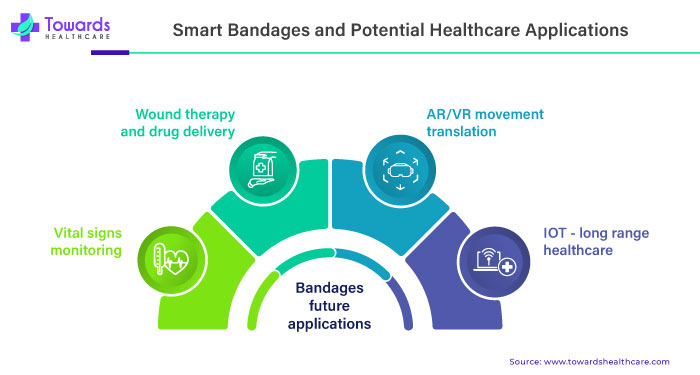
The market for smart bandages is subject to government rules and laws. As they are used for therapeutic uses, smart bandages are regarded as medical devices. As such, they are subject to strict regulatory criteria and procedures that guarantee their safety, efficacy, and quality. Countries and regions may have different laws and policies.
In the US, the Food and Drug Administration (FDA) is responsible for regulating smart bandages. Depending on the device's risk category, they must undergo a premarket approval method or 510(k) clearance procedures. Based on the level of risk they pose to patients, the FDA divides medical devices into three categories (Class I, II, and III). In addition, before being marketed and sold in the European Union, smart bandages must adhere to the Medical Device Regulation (MDR) and receive a CE mark. The CE marking certifies that the item complies with all the health, environmental, and safety standards set forth by the European Union.
Furthermore, several International Organization for Standardization (ISO) standards, including ISO 13485, which outlines the specifications for a quality management system for medical devices, may also apply to smart bandages.
Clinical trials and research may be necessary to prove the safety and efficacy of smart bandages. It could be necessary to submit the findings of these trials for assessment by regulatory authorities. To negotiate the regulatory environment and guarantee compliance with all relevant laws and standards, makers of smart bandages must cooperate closely with regulatory authorities and legal professionals.
The significantly rising incidence of chronic wounds such as venous ulcers, pressure ulcers, diabetic foot ulcers, and others ultimately augments the smart bandage market growth.
According to the National Library of Medicine, this chronic wound population increased to 8.2 million Medicare beneficiaries, i.e., 2% of the total U.S. population, until August 2023, costing $28 billion annually. One must comprehend the typical healing process and create a healthy physical and biochemical environment in order to manage these issues efficiently. This is where smart bandages can work and heal effectively.
The following facts also account for the smart bandages market growth:
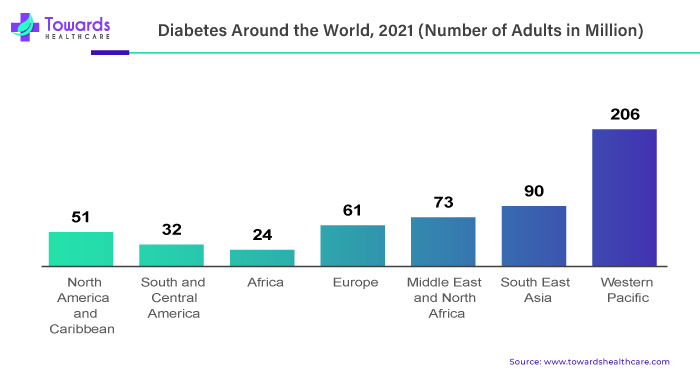
Diabetic ulcers cause the majority of foot and leg amputations in the U.S.. According to research by Rice et al., diabetic foot ulcers increase the cost of diabetes by $9–13 billion for Medicare and commercial insurance. In addition, around 537 million adults. (aged 20-79 years) suffered from diabetes in 2021, and number of individuals with diabetes are predicted to reach around 784 million in 2045. The rising number of diabetes patients also increases the number of patients who might suffer from a diabetic foot ulcer, which in turn massively adds to the growth of the smart bandages market.
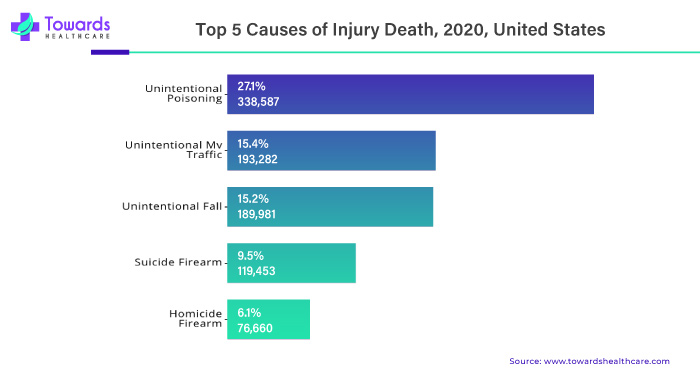
The rising incidences of chronic injuries across the globe are significantly bolstering the smart bandages market growth. Smart bandages are considered a really smarter way of wound healing as they offer rapid wound healing through drug delivery and real-time monitoring. The rise in the incidence of chronic wounds, such as diabetic and venous ulcers, is undoubtedly a major element fueling the market for smart bandages. Due to their intricacy, lengthy healing durations, and related problems, chronic wounds considerably strain healthcare systems globally. The prevalence of chronic wounds is anticipated to climb further as the world's population ages and the prevalence of diabetes and other chronic illnesses rises.
Smart bandage adoption may be significantly hampered by their expensive cost, particularly in underdeveloped nations and healthcare settings with limited resources. Technology-advanced smart bandages include sensors, microprocessors, communication modules, and, occasionally, medicine delivery devices. Creating, producing, and integrating these parts may increase the cost of smart bandages relative to conventional bandages.
Healthcare institutions in underdeveloped nations and places with limited resources often need help to set aside enough money to purchase and upkeep smart bandages. The price of educating medical staff members on how to utilize the technology efficiently and the potential requirement for supporting infrastructure, including dependable internet connectivity and data storage options, might also raise the overall costs.
The production costs of smart bandages can be decreased through improvements in manufacturing methods and materials in order to address this problem. Additionally, collaborations between the public and corporate sectors and international finance and aid can lower the price of smart bandages and increase their availability in areas with limited resources.
Ultimately, even though some areas may find it difficult to adopt smart bandages due to their high price, continued initiatives to lower costs and make them more accessible can assist in improving their adoption and optimize their potential benefits for wound care and management.
The market for smart bandages has much to gain from partnerships and collaborations between healthcare providers, technology firms, and producers of medical devices. These partnerships combine varied skills, resources, and knowledge, promoting creativity and accelerating the creation of more sophisticated and advanced smart bandages. In contrast to technology businesses, which bring modern technologies like sensors, microelectronics, and communication systems, medical device manufacturers are competent in designing and producing medical goods.
On the other hand, healthcare professionals can provide helpful information on the demands and difficulties of managing wounds. By cooperating and generating synergies, these parties can develop smart bandages with increased features, better use, and better integration into healthcare systems. For instance, partnerships can result in the development of smart bandages with more precise sensors, efficient drug delivery systems, and user-friendly user interfaces that are tailored to the particular needs of various patient populations and types of wounds.
Partnerships can also speed up clinical trials and investigations, guaranteeing that the smart bandages are thoroughly tested for efficacy and safety. This may hasten regulatory approvals and commercial availability, assisting in the quicker delivery of innovative therapies to patients. Because of this, partnerships and collaborations offer a huge chance to promote innovation, expand product offerings, and eventually improve the management of chronic wounds and other forms of injuries through the usage of smart bandages.
By product, the graphene segment held a dominant presence in the smart bandages market in 2024. Graphene is most widely used to prepare smart bandages due to its electrical conductivity, high surface area, and biocompatibility. The conductivity of the graphene electrode varies according to the physicochemical changes in the wound. Graphene is ultra-flexible and can adapt to any body part. Additionally, it is inert, i.e., it does not interfere with wound healing. On the contrary, it actively stimulates the process. All these properties promote the use of graphene in smart bandages, boosting the segment’s growth.
By product, the synthetic fiber segment is predicted to witness significant growth in the market over the forecast period. Synthetic fibers such as rayon and polyester are becoming popular due to their strength and durability. They are also very flexible and take the shape of a body part. They are relatively affordable and easily available. Synthetic fibers enable the integration of sensors to monitor and respond to wound conditions.
By application, the chronic skin wounds from burns segment led the global market in 2024. Chronic burn wounds as a result of metabolic, immune, and inflammatory responses are challenging to manage. Burn injuries do not generally heal properly and remain open for an extended period, resulting in significant scarring, potential infections, and functional limitations. These potential adverse effects promote the demand for smart bandages. Smart bandages not only heal the wound but also deliver appropriate drugs through their surface.
By application, the chronic skin wounds from diabetes segment will gain a significant share of the market over the studied period. The rising prevalence of diabetes and its complications potentiate the segment’s growth. According to the WHO, more than 830 million adults globally are living with diabetes. It is estimated that approximately 15% to 25% of diabetic patients will develop foot ulcers in their lifetime. Diabetic wounds or foot ulcers are the most complicated and may even lead to foot amputations. Such severity leads to the use of smart bandages for its cure.
By distribution channel, the retail pharmacies segment held the largest share of the market in 2024. The increasing number of retail pharmacies and the presence of trained professionals favor the segment’s growth. Retail drug stores usually keep a stock of advanced products to stay competitive in the market. They provide 24x7 facilities and free home delivery services to the customers. They also provide special discounts for customers.
By distribution channel, the hospital pharmacies segment is anticipated to show lucrative growth in the market over the coming years. Stringent regulatory frameworks and favorable reimbursement policies contribute to the segment’s growth. The increasing number of hospitalizations due to rising acute and chronic wounds or injuries also facilitates the use of smart bandages. Suitable capital investment and the availability of specialized equipment and medical devices further drive the segment’s growth.
North America dominated the global smart bandages market in 2024. The increasing adoption of advanced technologies and increasing investments boost the market. The presence of key players and favorable regulatory policies also contribute to the market. State-of-the-art research and development facilities promote the development of smart bandages. Countries like the U.S. and Canada are at the forefront of the development and use of smart bandages. The increasing healthcare expenditure also supports the use of smart bandages. The rising number of clinical trials to evaluate the safety and efficacy of bandages augments the market. Moreover, advanced healthcare infrastructure and an increasing number of pharmacies also contribute to the market.
The U.S. market is expanding due to rising chronic conditions like diabetes and obesity, which increase demand for advanced wound care. These bandages offer real-time monitoring, enabling early interventions and reducing healthcare costs. Technological advancements and a shift towards personalized, remote healthcare further drive this growth.
The Canadian market is growing due to an aging population and conditions like diabetes, which increase demand for advanced wound care. Smart bandages offer real-time monitoring and personalized treatment, enhancing patient outcomes and reducing healthcare costs. Technological advancements and increased awareness about wound management further drive this growth.
Asia-Pacific is projected to host the fastest-growing market in the coming years. The rising prevalence of acute and chronic wound cases and the increasing geriatric population drive the market. According to the Indian Council of Medical Research (ICMR), the prevalence of diabetes in India is 10.1 crores (>100 million) as of 2023. The increasing investments, collaborations, and mergers & acquisitions promote the development of smart bandages. The growing awareness about smart bandages and the rising disposable income potentiate market growth. Additionally, the burgeoning healthcare sector and the growing research and development activities favor the market. Japan’s total healthcare expenditure was around 47.3 trillion yen in FY2023, an increase of 2.9% from the previous year.
China's market is expanding due to factors such as an aging population, rising chronic diseases like diabetes and hypertension, and a growing focus on digital health. Government initiatives like the "Healthy China 2030" plan and technological advancements in AI and IoT are accelerating adoption. Additionally, increased health awareness and demand for remote monitoring solutions are fueling growth.
India's market is escalating due to a rise in chronic diseases, increased healthcare investments, and growing awareness of advanced wound care. Government initiatives promoting digital health and technological innovations like real-time monitoring and IoT integration are further boosting demand, especially in rural and remote areas needing efficient care.
Europe is notable in the smart bandages market due to its aging population, advanced healthcare infrastructure, and strong investment in medical research. Rising chronic diseases like diabetes drive demand for innovative wound care. Supportive regulations and increased awareness further boost adoption, making Europe a key region for smart bandage growth.
The UK market is growing due to increasing sports injuries, technological innovation from leading universities, and strong support from the healthcare system. Advanced features like biosensors and wireless monitoring enhance patient care. These innovations, combined with rising chronic disease cases, drive adoption and position the UK as a key player.
Germany's market is expanding due to its aging population, rising chronic wound cases, and advanced healthcare infrastructure. Strong investments in medical technology and innovation drive the development of smart, sensor-equipped bandages. These solutions offer real-time monitoring and improved care, making them increasingly adopted across hospitals and home healthcare settings.
Professor Steve Beeby, RAEng chair in emerging technologies at the University of Southampton, commented that the development of UV light in smart bandages could provide a significant benefit to the treatment of persistent wounds and is a major advance over typical smart bandages that attempt to monitor wound condition.
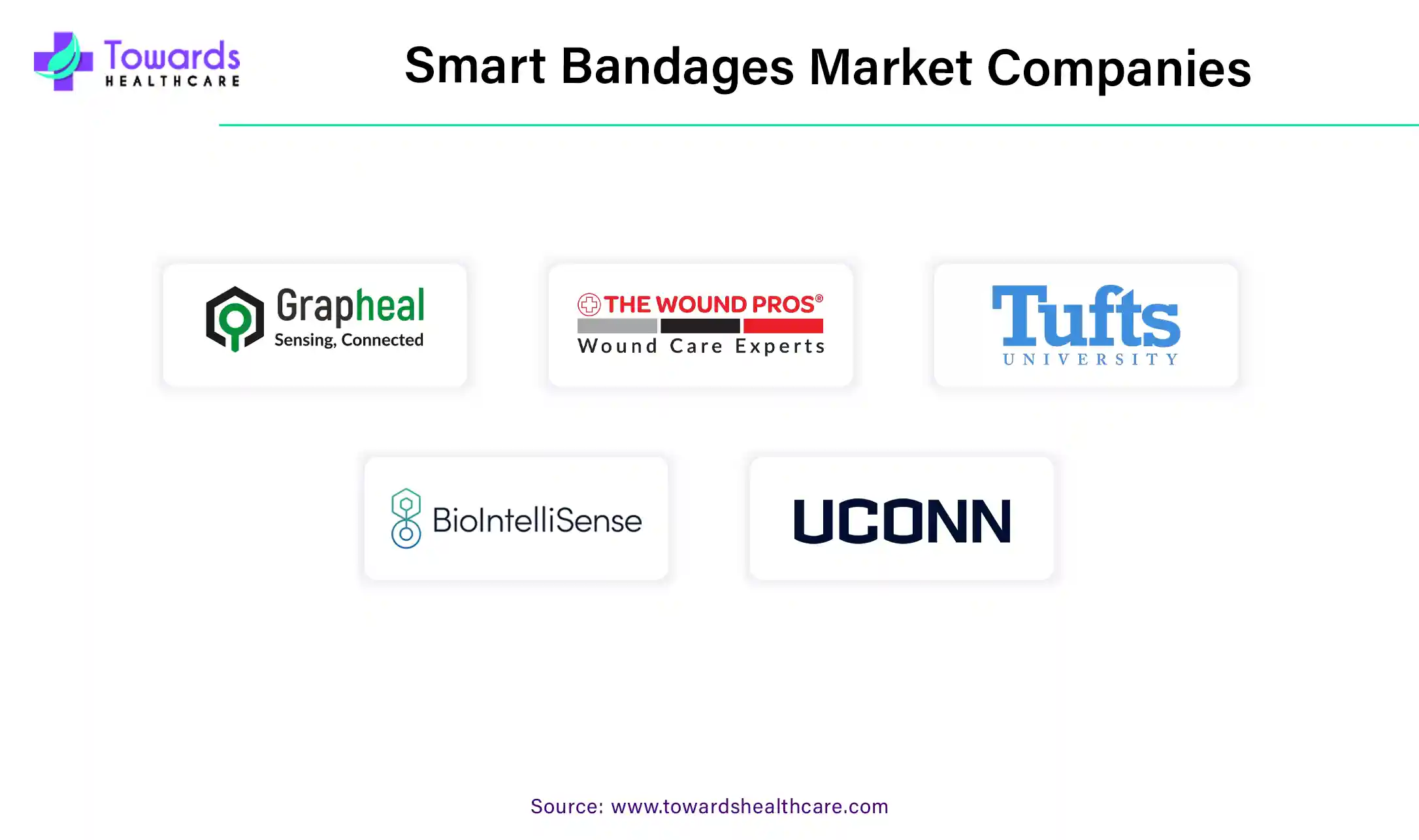
By Product
By Application
By Distribution Channel
By Region
October 2025
November 2025
November 2025
November 2025